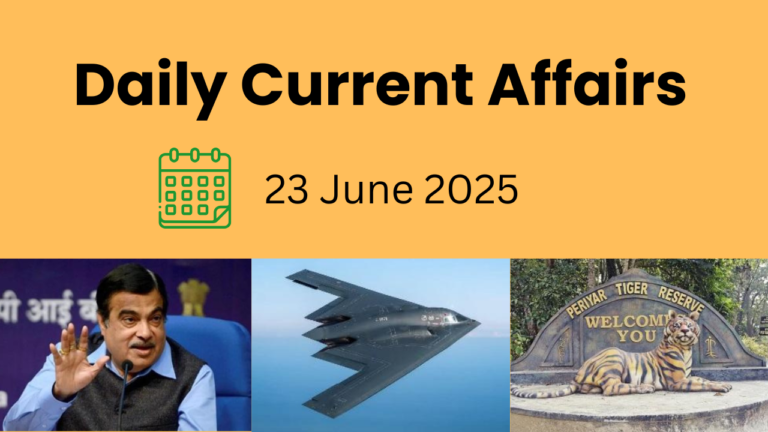1. Delimitation in India: Impact on Southern States & Parliamentary Representation
Context: Union Home Minister Amit Shah assured that southern states will not lose parliamentary seats after delimitation, addressing concerns raised by states like Tamil Nadu and Kerala.
The North-South population divide has been a major issue, as population growth in the North has been significantly higher than in the South. If delimitation were solely based on population data, northern states would gain more seats, while southern states could lose political influence.
Delimitation, which redraws constituency boundaries, was initially set for 2026 but has been delayed due to the postponed Census. India has conducted four rounds of delimitation in 1952, 1963, 1973, and 2002.
Why is Delimitation Necessary?
Delimitation is a constitutional requirement conducted after each Census to ensure fair representation in Parliament and state Assemblies.
- Article 82 of the Constitution mandates the adjustment of Lok Sabha seats after every Census based on population changes.
- Article 81 sets a limit of 550 Lok Sabha seats (530 from states and 20 from Union Territories).
- The seat-to-population ratio must remain uniform, ensuring equal representation across constituencies.
History of Delimitation in India:
Pre-1976:
- After the 1951, 1961, and 1971 Censuses, seats in Lok Sabha, Rajya Sabha, and state Assemblies were reallocated to reflect population changes.
42nd Amendment (1976):
- During the Emergency, Parliament froze the total number of Lok Sabha seats until 2001 to protect representation of states that controlled population growth.
2001 Delimitation:
- Constituency boundaries were redrawn, but the number of seats remained unchanged due to opposition from southern states.
Impact of Delimitation on Lok Sabha Seats & Elections:
The allocation of seats will depend on the base average population set by the future Delimitation Commission.
Potential Increase in Lok Sabha Strength:
- In 1977, each MP represented 10.11 lakh people. If this ratio is maintained, the Lok Sabha strength could rise to 1,400 seats based on 2025 population projections.
- UP (including Uttarakhand) could see its seats triple from 85 to 250, while Bihar (including Jharkhand) could grow from 25 to 82.
- Tamil Nadu (39 to 76) and Kerala (20 to 36) would see only moderate increases.
However, the new Parliament building has only 888 seats, making this formula unlikely.
Impact on Elections:
- Southern regional parties fear that population-based delimitation will favor North India-based parties, shifting the balance of power.
- The increase in seats for northern states could lead to a political disadvantage for southern states in Parliament.
Why Are Southern States Concerned?
- Southern states fear a loss in parliamentary representation, which could weaken their national political influence.
- Tamil Nadu CM M.K. Stalin has called an all-party meeting on March 5 to discuss delimitation concerns.
- He warned that Tamil Nadu could lose seats due to its success in population control, making it a victim of its own development.
Conclusion:
Delimitation remains a sensitive and politically charged issue in India. While equal representation is essential, it must be balanced to ensure that states that have effectively controlled population growth are not unfairly penalized. The final decision on delimitation will shape India’s political future, influencing governance and policy-making for years to come.
2. Trump’s $5M Gold Card Visa: Impact on US Immigration & Indian Investors
Context: Former US President Donald Trump has introduced a new “Gold Card” visa program, aiming to replace the existing EB-5 visa system.
Under this proposal, foreign investors can secure U.S. residency and a path to citizenship by making a $5 million investment.
The existing EB-5 visa program, launched in 1990, allows foreign investors to gain a Green Card with a minimum investment of $1.05 million (or $800,000 in distressed areas). However, the EB-5 program has faced allegations of fraud and misuse, including its involvement in funding Trump family businesses.
Understanding the EB-5 Visa Program:
Objective:
Established in 1990, the EB-5 visa was designed to boost the U.S. economy through job creation and capital investment by foreign investors.
Investment Requirements:
- Foreign nationals must invest at least $1,050,000, or $800,000 in economically distressed regions (Targeted Employment Areas – TEAs).
- Investments must lead to the creation of at least 10 full-time jobs for U.S. workers.
Annual Cap & Reservations:
- The EB-5 program is capped at 10,000 visas per year.
- 3,000 visas are reserved for investments in high-unemployment areas.
Criticism & Controversies:
- The program has been accused of funding luxury projects instead of promoting economic growth.
- Trump family businesses have allegedly benefited from EB-5 funds.
- Critics argue that it has deviated from its original goal of job creation.
Legal Challenges & Reforms:
- President Biden renewed the program in 2022, raising investment thresholds.
- In 2019, Trump attempted to increase the minimum investment to $900,000, but the decision was overturned by a federal judge in 2021.
Administration & Processing:
- The USCIS (United States Citizenship and Immigration Services) will likely oversee the program.
- The Department of State & Department of Commerce may also be involved in regulating foreign investments.
Potential Benefits of the Gold Card Visa:
Attracting Ultra-Wealthy Investors:
- The simplified residency pathway may encourage high-net-worth individuals to move to the U.S.
- Wealthy investors could boost the real estate sector, luxury markets, and local economies.
Minimizing Fraud Risks:
- The EB-5 program faced fraud allegations, leading to calls for stricter regulations.
- A direct high-cost purchase model could reduce misuse and eliminate loopholes.
Concerns & Criticism of the Gold Card Visa:
“Citizenship for Sale” Controversy:
- Prioritizing wealth over merit could disadvantage skilled professionals seeking U.S. residency.
- Raises ethical and political concerns regarding fairness in immigration policy.
Risk of Financial Misuse:
- Investment-based immigration programs are often linked to money laundering and foreign influence.
- Without strong regulatory oversight, such a program could pose security risks.
No Economic Contribution Requirement:
- Unlike EB-5, the Gold Card Visa does not mandate job creation or business investment.
- Passive investors could gain residency without contributing to the U.S. economy.
Policy Precedents & Global Examples:
- Canada discontinued a similar program due to widespread misuse and lack of economic benefits.
- Raises key questions:
- Should U.S. citizenship be available for purchase?
- Should immigration prioritize skills over wealth?
Challenges in Implementing the Gold Card Program:
Legislative Hurdles in Congress:
- Immigration policy changes require Congressional approval.
- While Republicans hold a majority, not all may support a program seen as “selling citizenship.”
- Democrats are expected to oppose the initiative.
Legal Uncertainty:
- Most legal challenges in immigration arise from administration rather than policy.
- It remains unclear how courts will respond to this proposal.
Impact on Indian Investors & Green Card Aspirants:
Limited Appeal for Indian Investors:
- In 2023, only 631 Indians secured Green Cards through the EB-5 program.
- With a $5 million price tag (43 crore), the Gold Card may not attract many Indian investors.
Impact on Green Card Applicants from Other Categories:
- Over 1 million Indians are currently waiting for U.S. Green Cards.
- In employment-based categories, the backlog for Indian applicants is expected to reach 2.19 million by 2030.
- The introduction of the Gold Card Visa could further extend waiting periods for traditional applicants.
Final Thoughts:
The Gold Card Visa represents a controversial shift in U.S. immigration policy, favoring wealth over merit-based selection. While it aims to attract ultra-rich investors, concerns over economic impact, fairness, and security risks remain.
For Indian investors, the high cost and uncertain benefits make it a less attractive alternative to traditional Green Card routes. As discussions continue, the political and legal future of the Gold Card Visa remains uncertain.
3. Tariffs and India: Key Insights from GTRI’s Latest Report
Context: The Global Trade Research Initiative (GTRI) has released a comprehensive report analyzing the potential impact of the U.S. Reciprocal Tariff Plan on India’s exports. The study also outlines strategic actions for the Indian government and industry stakeholders to minimize economic losses.
Understanding the U.S. Reciprocal Tariff Plan:
The U.S. Reciprocal Tariff Plan is designed to address trade imbalances by imposing higher tariffs on countries with which the United States runs a trade deficit. If implemented, this plan could significantly alter India-U.S. trade relations, affecting multiple sectors.
How Will This Impact India?
Increase in Tariffs on Indian Exports:
- Currently, Indian exports face an average U.S. tariff of 2.8%.
- Under the new plan, this could increase to 4.9%, making Indian goods less competitive in the U.S. market.
Sector-Wise Impact of Higher Tariffs:
Agriculture: The Hardest Hit:
- Farm exports, including shrimp, dairy, and processed foods, could face tariffs as high as 38.2%.
- This would make Indian agricultural products more expensive in the U.S., reducing their demand.
Industrial Goods: Major Risks for Key Sectors:
- Pharmaceuticals, diamonds & jewelry, and electronics are expected to be heavily affected.
- The pharmaceutical sector alone could face a tariff hike of 10.9%, leading to higher costs for generic medicines and reduced global competitiveness.
Minimal Impact on Some Sectors
- Petroleum, minerals, and garments are expected to remain largely unaffected, as current trade agreements and demand dynamics keep these sectors stable.
Recommended Strategies for India:
- Propose an Advance Tariff Offer Instead of an FTA:
- India should offer a “zero-for-zero” tariff strategy, identifying products where tariffs can be eliminated for U.S. imports without harming domestic industries.
- This approach can prevent unilateral tariff hikes and maintain trade stability.
- Consider Retaliatory Measures:
- India should reject unfair trade concessions and be prepared to implement countermeasures if the U.S. imposes excessive tariffs.
- A strategy similar to China’s trade retaliation can help safeguard Indian economic interests.
- Resolve Trade Data Discrepancies:
- There is a significant difference in trade data reported by India and the U.S..
- Reconciling these discrepancies is crucial to prevent tariff decisions based on inaccurate figures.
Conclusion:
The U.S. Reciprocal Tariff Plan poses a serious challenge to Indian exports, particularly in agriculture and industrial goods. To mitigate potential losses, India must proactively engage in trade negotiations, push for fair tariff structures, and prepare for countermeasures if necessary. The GTRI report serves as a crucial roadmap for both the government and industry leaders to navigate the evolving global trade landscape.
4. Nuclear Weapons: A Path to Annihilation, Warns UN Chief
Context: The United Nations Secretary-General has issued a stark warning, calling nuclear weapons a “one-way road to annihilation.” His statement comes amidst rising global tensions and growing concerns over nuclear proliferation.Adding to the urgency, the Doomsday Clock was moved one second closer to midnight last month, symbolizing an increased risk of global catastrophe.
What is the Doomsday Clock?
- Introduced in 1947 by the Bulletin of the Atomic Scientists, the Doomsday Clock is a symbolic measure of how close humanity is to self-destruction due to nuclear threats, climate change, and emerging technologies.
- The clock now stands at just 90 seconds to midnight, the closest it has ever been.
Current Threats Posed by Nuclear Weapons:
Rising Global Security Concerns:
- Geopolitical tensions and declining trust among nations are increasing the chances of nuclear conflict.
- High military spending on nuclear capabilities is worsening global instability.
Weakening of Disarmament Agreements:
- Key international treaties and agreements aimed at nuclear disarmament are being undermined.
- The erosion of anti-proliferation frameworks makes nuclear war a more imminent threat.
Nuclear Blackmail: A Dangerous Tactic:
- Nations are increasingly using nuclear threats to intimidate or coerce rivals, further destabilizing international peace.
Expansion of Nuclear Inventories:
- Several countries are actively increasing their nuclear arsenals, igniting a new arms race.
- Weapons development has extended to outer space, posing unprecedented risks.
Artificial Intelligence and the Risk of Uncontrolled Escalation:
- The weaponization of AI could lead to reduced human oversight in nuclear decision-making.
- This increases the danger of unintended nuclear launches due to automated systems and miscalculations.
Global Efforts to Prevent Nuclear Proliferation:
- Conference on Disarmament:
- A multilateral forum addressing nuclear disarmament, space security, and new-age weapons threats.
- Treaty on the Non-Proliferation of Nuclear Weapons (NPT):
- Prevents the spread of nuclear weapons and promotes peaceful nuclear energy use.
- Comprehensive Nuclear-Test-Ban Treaty (CTBT):
- Aims to eliminate all nuclear explosions, whether military or civilian.
- International Atomic Energy Agency (IAEA):
- The leading global body for scientific and technical cooperation in peaceful nuclear energy applications.
Conclusion:
With growing nuclear threats, increasing global tensions, and a weakening commitment to disarmament, the world stands at a critical crossroads. The UN Chief’s warning serves as a reminder that nuclear weapons pose an existential threat to humanity. Urgent action is needed to strengthen disarmament efforts, reinforce treaties, and prevent a catastrophic future.
5. Time Use Survey 2024: Key Findings and Insights
Context: The Ministry of Statistics and Programme Implementation has recently released the Time Use Survey (TUS) 2024, marking the second all-India survey of its kind.
What is the Time Use Survey (TUS)?
The Time Use Survey helps in measuring the time spent by individuals on various daily activities.
Objectives of the Survey:
- To assess the participation of men, women, and other groups in both paid and unpaid activities.
- To gather insights into unpaid caregiving, volunteer work, and domestic services.
- To analyze the time spent on learning, socializing, leisure, and self-care activities.
Conducted by: National Statistics Office (NSO):
Nodal Ministry: Ministry of Statistics & Programme Implementation:
Key Findings of Time Use Survey 2024:
Survey Duration: January – December 2024:
Major Indicators:
- Participation Rate:
- Definition: The percentage of individuals engaging in a specific activity during the day.
- Average Time Spent per Participant:
- This measures the average time spent by individuals who participated in a specific activity.
- Average Time Spent per Person:
- This accounts for all individuals, whether they participated in an activity or not, distributing the total 1440 minutes of a day across different tasks.
Key Trends and Changes in 2024:
Rising Employment Participation:
- 75% of men and 25% of women (aged 15-59) were involved in employment and related activities in 2024.
- In 2019, this participation was 70.9% for men and 21.8% for women.
Shift from Unpaid to Paid Work:
- Women aged 15-59 spent 305 minutes on unpaid domestic services in 2024, compared to 315 minutes in 2019, indicating a shift towards paid activities.
Caregiving Responsibilities:
- 41% of women (15-59 years) participated in caregiving for household members, compared to 21.4% of men in the same age group.
- Women spent 140 minutes per day on caregiving, while men spent only 74 minutes.
- This highlights the continued gender disparity in caregiving roles within Indian households.
Household Production in Rural Areas:
- 24.6% of the rural population (aged 15-59) engaged in producing goods for their own use, spending an average of 121 minutes daily.
Learning Among Children:
- 89.3% of children (6-14 years) participated in learning activities, dedicating an average of 413 minutes daily to their education.
Increase in Leisure Activities:
- People aged 6 years and above spent 11% of their daily time on cultural, leisure, media, and sports activities in 2024, compared to 9.9% in 2019.
Time Spent on Self-Care and Maintenance:
- Individuals aged 6 years and above devoted 708 minutes per day to self-care and maintenance.
- Women spent 706 minutes, while men spent 710 minutes, showing a balanced focus on personal well-being.
Conclusion:
The Time Use Survey 2024 provides valuable insights into changing work patterns, gender roles, and daily routines in India. The data reveals rising employment participation, a gradual shift of women from unpaid to paid work, and a steady increase in leisure activities. Understanding these trends will help shape better policies for labor, gender equality, and social welfare in the future.
6. Gallantry Awards for Indian Coast Guard Personnel
Context: The Defence Minister recently conferred Gallantry, Distinguished Service, and Meritorious Service Medals to the Indian Coast Guard (ICG) personnel in recognition of their exceptional service and bravery.
Gallantry Awards: Recognizing Heroism:
Gallantry Awards are bestowed upon armed forces personnel, other security forces, and civilians for acts of valor and bravery. These awards are traditionally announced on Republic Day (January 26) and Independence Day (August 15).
Order of Precedence for Gallantry Awards:
- Param Vir Chakra – India’s highest military honor for valor in battle.
- Ashoka Chakra – The highest peacetime gallantry award.
- Maha Vir Chakra – The second-highest war-time gallantry award.
- Kirti Chakra – The second-highest peacetime gallantry award.
- Vir Chakra – The third-highest wartime gallantry award.
- Shaurya Chakra – The third-highest peacetime gallantry award.
Indian Coast Guard (ICG): Guardians of Maritime Security:
About the ICG:
The Indian Coast Guard (ICG) is a maritime security force tasked with enforcing maritime laws and ensuring coastal defense. It functions under the Ministry of Defence.
- Established: 1st February 1977
- Independent Armed Force Status: 18th August 1978 (after the enactment of the Coast Guard Act, 1978)
Why was the ICG Formed?
- In 1972, the United Nations Convention on the Law of the Sea (UNCLOS) granted Exclusive Economic Zones (EEZs) to coastal states.
- In response, India enacted the Maritime Zones of India Act, 1976, claiming 2.01 million sq km of ocean territory.
- This vast maritime region required policing and surveillance, leading to the formation of the Indian Coast Guard.
Jurisdiction of the ICG:
The ICG operates across India’s maritime zones, ensuring law enforcement and security:
- Territorial Waters: Up to 12 nautical miles (nm)
- Contiguous Zone: Up to 24 nm
- Exclusive Economic Zone (EEZ): Up to 200 nm
ICG’s Global Standing:
The Indian Coast Guard is the 4th largest Coast Guard in the world, reflecting India’s strong maritime defense capabilities.
Conclusion:
The recognition of ICG personnel with Gallantry and Service Awards highlights their courage, dedication, and commitment to safeguarding India’s maritime borders. Their role remains crucial in ensuring national security, enforcing maritime laws, and protecting India’s vast oceanic territory.




